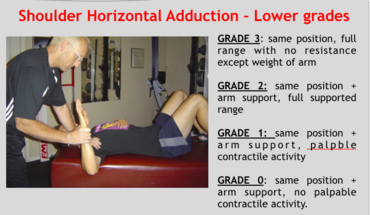Shoulder Mobilization
Original Editor - David Drinkard, Dana Tew.
Top Contributors - Dana Tew, Nupur Smit Shah, David Drinkard, Braden Osman, Admin, Jacob Bischoff, Kim Jackson, Lucinda hampton, Aminat Abolade, 127.0.0.1, Rachael Lowe, Kai A. Sigel, WikiSysop, Tony Varela and Mariam Hashem
This page is under construction. Please come back soon to read the finished work. (20th January 2022)
Introduction[edit | edit source]
Shoulder mobilization is commonly used in clinical practice. It is applied in cases where the ROM is restricted. Shoulder mobilization (Maitland technique) is described on this page.
The shoulder comprises of glenohumeral joint, scapulothoracic joint, sternoclavicular joint, and acromioclavicular joint. Hence the mobilisation of all four joints is covered.
Manual therapy interventions for the shoulder have been associated with improvements in pain and function in individuals with :
- Subacromial Pain Syndrome,
- Adhesive capsulitis
- Rotator cuff tendinopathy.
- Postoperative cases of humerus/clavicle fracture
- Post-traumatic cases of humerus/clavicle fractures [1]
Below are some of the techniques at our disposal.
Glenohumeral mobilization[edit | edit source]
The head of the humerus is convex and the glenoid fossa is concave.
Loose pack position[edit | edit source]
Shoulder abduction 55 degrees and horizontal adduction of 30 degrees.
Treatment plane[edit | edit source]
The treatment plane is along the glenoid fossa and moves with the scapula as it moves in rotation.
Glenohumeral distraction[edit | edit source]
Indications[edit | edit source]
Distraction is usually applied during initial treatment to reduce pain and general mobility.
Position of the patient[edit | edit source]
The patient is in a supine lying position and the shoulder is in a resting position.
Hand placement[edit | edit source]
The therapist's hand is placed in the axilla with the thumb distal to the joint margin anteriorly and fingers posteriorly.
The other hand supports the lateral part of the humerus.
Mobilizing hand[edit | edit source]
The therapist moves the hand in the axilla laterally to distract the humerus. Distraction is sustained for a few seconds.
Glenohumeral caudal glide(resting position)[edit | edit source]
Indications[edit | edit source]
To increase abduction or correct the humerus positional fault if it is superior to normal.
Patient Position[edit | edit source]
Supine lying and the arm in the loose pack position. The therapist supports the arm between the trunk and the elbow.
Hand placement[edit | edit source]
One hand of the therapist is placed in the axilla to give distraction(grade 1)
The therapist's other hand(webspace) is kept just below the acromion process.
Mobilizing force[edit | edit source]
The force is applied on the head of the humerus in the inferior direction, through the hand which is placed superiorly.
GH caudal glide (resting position and progression)[edit | edit source]
GH posterior glide, resting position[edit | edit source]
Indications[edit | edit source]
To improve flexion and internal rotation of the shoulder
Position of patient[edit | edit source]
Supine lying while keeping the arm in resting position.
Position of the therapist and hand placement[edit | edit source]
The therapist stands with the back towards the patient, in between the arm and the trunk.
The distal aspect of the arm is grasped against the trunk of the therapist to give grade one distraction to the shoulder joint.
Another hand is placed over the joint (distal to anterior margin) to provide the mobilizing force.
Mobilizing force[edit | edit source]
The head of the humerus is glided posteriorly.
GH posterior glide (progression)[edit | edit source]
Indications[edit | edit source]
For increasing horizontal adduction. For increasing posterior gliding when flexion approaches 90 degrees.
Patient Position[edit | edit source]
Supine lying position, shoulder flexion upto 90 degrees and internal rotation with elbow flexion.
Placement of hand[edit | edit source]
The scapula is supported by placing a towel roll beneath it.
The therapist places one hand over the proximal humerus for applying grade 1 distraction.
Another hand is placed over the elbow joint.
The therapist places around the pelvis to distract the humerus.
Mobilizing force[edit | edit source]
The glide is applied on the humerus in the posterior direction by pushing the elbow along the long axis of the humerus.
Inferior Glenohumeral Mobilization[edit | edit source]
GH anterior glide (Resting position)[edit | edit source]
Indications[edit | edit source]
To increase the extension of the shoulder with external rotation.
Position of the patient[edit | edit source]
Prone lying at the edge of the plinth, the limb is in resting position. Acromion is stabilized by placing the towel underneath.
Position of the therapist with hand placement[edit | edit source]
The patient's arm is supported on the therapist's thigh and the therapist stands on the top of the table and places one hand over the arm to give distraction at GH joint.
Mobilizing hand's ulnar border is placed just next to the posterior angle of the acromion.
Mobilizing force[edit | edit source]
It is applied to the humeral head in the anterior direction.
Scapulothoracic Mobilization[edit | edit source]
Scapulothoracic mobilization is performed when there is dysfunction of the scapulothoracic articulation (e.g. restriction of upward rotation or lateral glide). Mobilizations that are commonly used include medial/lateral glides, superior/inferior glides, upward and downward rotation, and diagonal patterns.
- Patient position- typically, the patient is lying side-lying with the involved side up and the arm resting on the therapist's arm. The therapist stands in front of the patient, facing them. Hand contacts for these glides are the inferior angle of the scapula and the acromion. Direction and magnitude of force depend upon the technique being utilized and the desired amount of motion.[4]
References[edit | edit source]
- ↑ medbridge Manual Therapy Available: https://www.medbridgeeducation.com/techniques/evidence/2-Shoulder/ (accessed 30.9.2021)
- ↑ Posterior Glide to increase flexion and internal rotation. Available from: https://www.youtube.com/watch?v=At5YYf-LtjU
- ↑ Manual Therapy for the glenohumeral joint. Available from: https://www.youtube.com/watch?v=XnynTee7kak
- ↑ Hertling D, Kessler RM. Management of Common Musculoskeletal Disorders: Physical Therapy Principles and Methods. 4th ed. LW&W, Philadephia, 2006.







